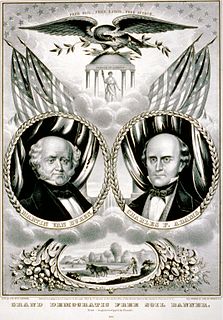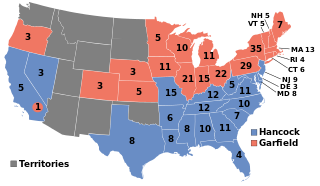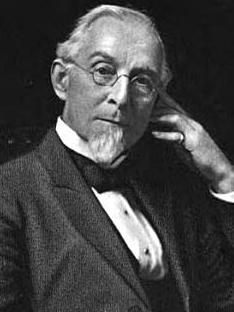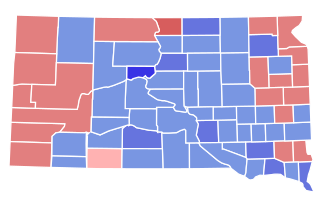| |||||||||||||||||||||
| |||||||||||||||||||||
| |||||||||||||||||||||
| Elections in Iowa |
|---|
 |
The 1881 Iowa gubernatorial election was held on October 11, 1881. Republican nominee Buren R. Sherman defeated Democratic nominee L. G. Kinne with 56.72% of the vote.
| |||||||||||||||||||||
| |||||||||||||||||||||
| |||||||||||||||||||||
| Elections in Iowa |
|---|
 |
The 1881 Iowa gubernatorial election was held on October 11, 1881. Republican nominee Buren R. Sherman defeated Democratic nominee L. G. Kinne with 56.72% of the vote.
Major party candidates
Other candidates
| Party | Candidate | Votes | % | ±% | |
|---|---|---|---|---|---|
| Republican | Buren R. Sherman | 133,328 | 56.72% | ||
| Democratic | L. G. Kinne | 73,344 | 31.20% | ||
| Greenback | D. M. Clark | 28,112 | 11.96% | ||
| Majority | 59,984 | ||||
| Turnout | |||||
| Republican hold | Swing | ||||

The 1888 United States presidential election was the 26th quadrennial presidential election, held on Tuesday, November 6, 1888. Republican nominee Benjamin Harrison, a former Senator from Indiana, defeated incumbent Democratic President Grover Cleveland of New York. It was the third of five U.S. presidential elections in which the winner did not win a plurality of the national popular vote, which would not occur again until the 2000 US presidential election.

The Free Soil Party was a short-lived coalition political party in the United States active from 1848 to 1854, when it merged into the Republican Party. The party was largely focused on the single issue of opposing the expansion of slavery into the western territories of the United States.

The 1956 United States Senate elections were elections for the United States Senate that coincided with the re-election of President Dwight D. Eisenhower. Although Democrats gained two seats in regular elections, the Republicans gained two seats in special elections, leaving the party balance of the chamber unchanged.

In the United States Electoral College, a faithless elector is an elector who does not vote for the candidates for U.S. President and U.S. Vice President for whom the elector had pledged to vote, and instead votes for another person for one or both offices or abstains from voting. As part of United States presidential elections, each state selects the method by which its electors are to be selected, which in modern times has been based on a popular vote in most states, and generally requires its electors to have pledged to vote for the candidates of their party if appointed. A pledged elector is only considered a faithless elector by breaking their pledge; unpledged electors have no pledge to break. The consequences of an elector voting in a way inconsistent with their pledge vary from state to state.

The 1876 New York state election was held on November 7, 1876, to elect the governor, the lieutenant governor, a judge of the New York Court of Appeals, a Canal Commissioner and an Inspector of State Prisons, as well as all members of the New York State Assembly and two members of the New York State Senate. Besides, two constitutional amendments were proposed - to abolish the elected Canal Commissioners and appoint a Superintendent of Public Works instead; and to abolish the elected New York State Prison Inspectors and appoint a Superintendent of State Prisons instead - and both were accepted by the electorate.

The 1912 United States presidential election in Massachusetts took place on November 5, 1912, as part of the 1912 United States presidential election, which was held throughout all contemporary 48 states. Voters chose 18 representatives, or electors to the Electoral College, who voted for president and vice president.

The 1880 United States elections occurred during the Third Party System, and elected the members of the 47th United States Congress. Republicans retained the Presidency and took control of the House. An unclear partisan situation prevailed in the Senate. As the first presidential election after the end of Reconstruction, this election saw the first occurrence of the Democratic Party sweeping the Southern United States; the party would carry an overwhelming majority of Southern states well into the 20th century.

The 1960 United States Senate election in Kentucky took place on November 6, 1960. Incumbent Republican Senator John Sherman Cooper, who won a 1956 special election to fill the vacant seat of Alben Barkley, was elected to a full term in office, defeating Democratic former Governor and Undersecretary of Labor Keen Johnson.

The Boston mayoral election of 1899 occurred on Tuesday, December 12, 1899. Republican candidate and former mayor of Boston Thomas N. Hart defeated Democratic candidate Patrick Collins, and two other contenders, to become mayor for the second time. Incumbent mayor Josiah Quincy had announced in July 1899 that he would not seek re-election.

The 1972 Delaware gubernatorial election was held on November 7, 1972. Democratic nominee Sherman W. Tribbitt defeated incumbent Republican Governor Russell W. Peterson with 51.27% of the vote. This was the last time a Democrat won statewide office in Delaware until 1992, when Tom Carper won the gubernatorial election over Republican B. Gary Scott.

The 1948 New Hampshire gubernatorial election was held on November 2, 1948. Republican nominee Sherman Adams defeated Democratic nominee Herbert W. Hill with 52.21% of the vote.

The 1881 Ohio gubernatorial election was held on October 11, 1881. Incumbent Republican Charles Foster defeated Democratic nominee John W. Bookwalter with 50.10% of the vote.

The 1883 Iowa gubernatorial election was held on October 9, 1883. Incumbent Republican Buren R. Sherman defeated Democratic nominee L. G. Kinne with 50.15% of the vote.

The 1881 Rhode Island gubernatorial election was held on April 6, 1881. Incumbent Republican Alfred H. Littlefield defeated Democratic nominee Horace A. Kimball with 66.97% of the vote.

The 1928 South Dakota gubernatorial election was held on November 6, 1928. Incumbent Democratic Governor William J. Bulow ran for re-election to a second term. In the general election, he faced Attorney General Buell F. Jones, the Republican nominee. Despite Republican presidential nominee Herbert Hoover overwhelmingly defeating Democratic nominee Al Smith overwhelmingly in South Dakota, Bulow defeated Jones by a decisive margin to retain the governorship. In so doing, he became the first Democratic candidate for Governor to receive a majority of the vote in the state's history.

The 1881 Wisconsin gubernatorial election was held on November 8, 1881.

The 1884 Wisconsin gubernatorial election was held on November 4, 1884.